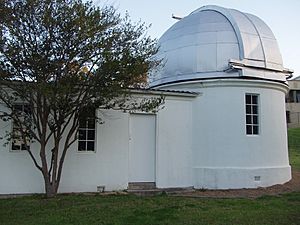Edward Pigot facts for kids
Edward Francis Pigot (born September 18, 1858 – died May 22, 1929) was an important Irish-born Australian Jesuit priest. He was also a scientist who studied earthquakes (a seismologist) and stars (an astronomer). He led the New South Wales branch of the British Astronomical Association and was a council member of the Royal Society of New South Wales.
Contents
Early Life and Education
Edward Pigot was born in Dundrum, Ireland. His father, David Richard Pigot junior, was a judge. His mother was Christina Murray. Edward was taught at home by tutors.
He later went to Trinity College, Dublin. He earned a degree in Arts in 1879. In 1882, he also earned a degree in Surgery.
Journey to Australia and Priesthood
Pigot taught at University College, Dublin for a while. In 1888, he moved to Australia because he wasn't feeling well. He taught science at St Francis Xavier's College in Melbourne. Then, from 1889, he taught at Saint Ignatius' College, Riverview in Sydney.
From 1892, he studied with other Jesuits in Jersey. He then studied theology in Dublin. Edward became a priest on July 31, 1898. He volunteered to work in China. He was at the Shanghai Astronomical Observatory until 1903. He then spent a year back in Australia. After three more years in China, he returned to Sydney.
Building an Observatory
Pigot had visited a Jesuit observatory in Manila. He wanted to build a great observatory in Riverview. He started taking weather observations there on January 1, 1908.
He also set up a station to study earthquakes. Pigot ordered special seismometers for this. The Riverview College Observatory opened as an earthquake study station in March 1909. Scientists still study earthquakes there today.
Scientific Expeditions and Discoveries
Between 1910 and 1922, Pigot traveled a lot. He went to Bruny Island in Tasmania, Tonga, and Goondiwindi, Queensland. He went to these places to watch total solar eclipses. He also visited many observatories in Europe and North America.
He measured tides and how the Earth's crust moves. He also did experiments with a foucault pendulum. In 1923, he observed a huge earthquake with a Japanese seismologist named Fusakichi Omori. This earthquake, known as the 1923 Great Kantō earthquake, destroyed Tokyo.
Later Work and Legacy
From 1925 to 1929, Pigot measured sunlight at Riverview and Orange. This information helped with long-range weather forecasts. He got sick with pneumonia while looking for a high place to set up equipment at Mount Canobolas.
Edward Francis Pigot died in North Sydney. He was buried in Gore Hill cemetery.
Edgeworth David, another scientist, spoke highly of him. He said that scientists admired Pigot not just for his knowledge. They also loved his friendly personality. Even when he was sick, he was always cheerful and excited. He loved talking about new ways to find scientific truth.
See also
- List of Roman Catholic scientist-clerics


